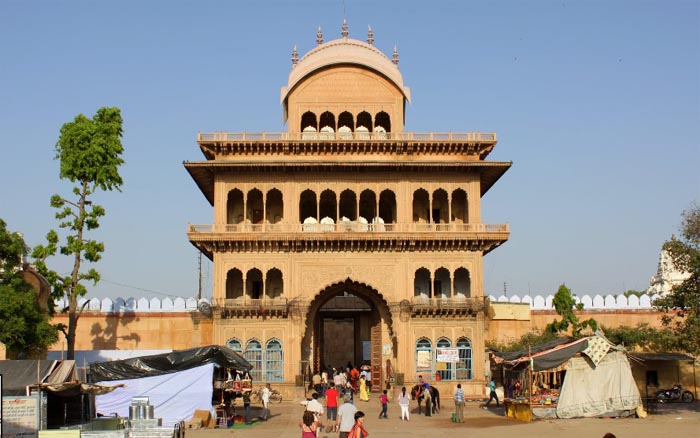Rangji Temple

Information of Rangji Temple, Vrindavan, Mathura, Uttar Pradesh
Rangji Temple is one of the biggest temples in entire North India. Situated in Vrindavan, Rangji Temple is a great example ancient architecture. It is characterised by patronising entrances, a tall crown and an imposing gold plated decoration. This great temple was created by Seth Gobind Das and Seth Radha Krishnan who are the brothers of popular Indian millionaire Laxmi Chand. Rangji Temple is devoted to lord Ranganatha or Rang Ji which is a special name of god Vishnu.
Rangji Temple Religious Significance
Apart from lord Vishnu, there are multiple sides of Rangji Temple comprising ones which is devoted to Vaishnava saints named Alwars, Tirupati Balaji and Ananta Sayanam. Furthermore, god Narasimha, lord Ram, Laxman and Sita, lord Venugopala and lord Ramanujacarya are also worshipped in Rangji Temple. The temple is maintained by the priests of lord Sampradaya, which starts from goddess Laxmi, the deity of fortune.
The reverence in Rangji Temple is established by Ramanujacarya. The worship activities in the temple are performed by South Indian priests. Traditionally, non-Hindus were not permitted to enter in the main temple premise where the statue of Lord Ranga Ji is installed. However at present, they are able to enter in the yard of Rangji Temple. However, non-Indians are not allowed to enter beyond the two entrances of Rangji Temple.
The annual festival which occur in Rangji Temple is Jal Vihar where the deity of Lord Ranga Ji is worshipped with great ceremony and splendour. Rangji Temple is also popular for Brahmotsdav celebration which occur during March or April month. This festival is also known as Rath Mela which is marked by 10 days carnival. During the festival, a chariot vehicle named Rath is pulled by the devotees from Rangji Temple to the attached garden. Prayers are performed within the temple and fireworks are also done for giving honour to lord Vishnu.
Rangji Temple Mythology & History
Ranganatha or Rang Ji was a popular Vaishnav saint of South India during 8th century. She composed Thiruppuvai songs which demonstrates her love for lord Krishna. She wanted lord Krishna, put diets for him, sang songs on his admiration and desired to acquire him by marriage. Lord Rang Ji is none other than the responses of lord Krishna on her prayers by becoming her husband. In Rangji Temple, lord Krishna is represented as the husband of Lord Ranga Ji with a walking stick in his hand which is typical tradition in South Indian marriages.
Lord Ranga Ji had demonstrated three desires in Nachiar Tirumozhi which comprise 143 verses on admiration towards lord Krishna. The first desire was to spend her life in the feet of lord Krishna. The second desire was to become the wife of lord Krishna and the third desire was to offer lord Krishna Kheer in 100 pots. Her first desire was satisfied by creating Rangji Temple where Lord Ranga Ji reside as divine couple. It is one of the few temples in India where usual ceremonies are occurred on the basis of prescribed Vedic customs. All there are done in a traditional way, following all the important rituals and customs, taking care of each and every details of the Vedic ritual.
Rangji Temple Architectural Significance
Rangji Temple is created on the basis of Dravidian style. The gateway of the temple is created by Rajput architectural style where the arcade has distinct Italian architectural format. There is about 8 gateways in Rangji Temple and one of the gateways is six storied and entirely enclosed with attractive artefacts. Among various gates, the western gateway is the primary entrance to Rangji Temple. In the western entrance, there are visuals from two Indian epics named Ramayana and Mahabharata. The inner portion of Rangji Temple is also gorgeously decorated. The most attractive feature of the temple is a 15 meter gold plated column in the central arena. Furthermore, inside the area of the temple, there a lovely reservoir and a beautiful garden. Apart from religious determination, due to fine architecture, Rangji Temple is visited by many travellers along with the devotees from across India and abroad.
- Andhra Pradesh Temples
- Assam Temples
- Bihar Temples
- New Delhi Temples
- Goa Temples
- Gujarat Temples
- Jammu and Kashmir Temples
- Karnataka Temples
- Kerala Temples
- Madhya Pradesh Temples
- Maharashtra Temples
- Odisha Temples
- Punjab Temples
- Rajasthan Temples
- Sikkim Temples
- Tamil Nadu Temples
- Telangana Temples
- Uttar Pradesh Temples
- Uttarakhand Temples
- West Bengal Temples